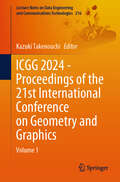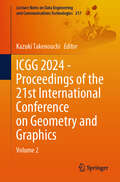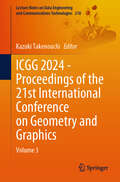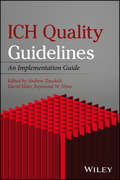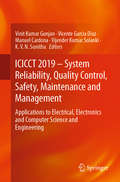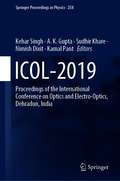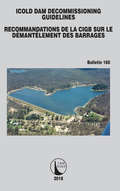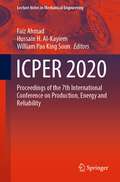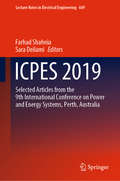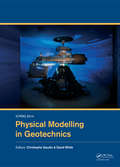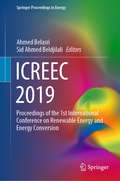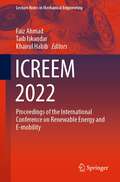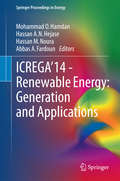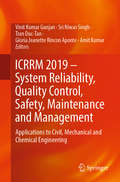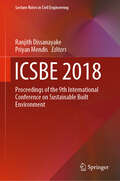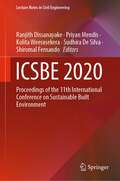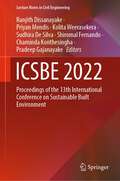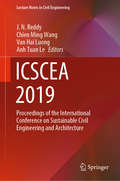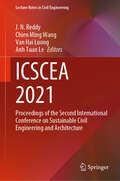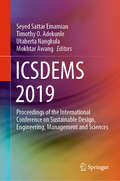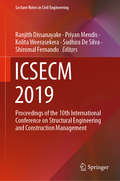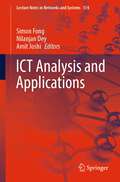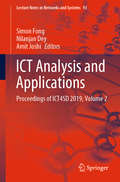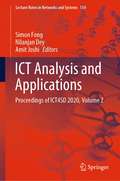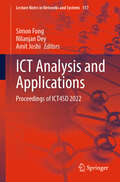- Table View
- List View
ICGG 2024 - Proceedings of the 21st International Conference on Geometry and Graphics: Volume 1 (Lecture Notes on Data Engineering and Communications Technologies #216)
by Kazuki TakenouchiThis three-volume book gathers peer-reviewed papers presented at the 21st International Conference on Geometry and Graphics (ICGG 2024), held in Kitakyushu, Japan, on August 5–9, 2024. The conference started in 1978 and is promoted by the International Society for Geometry and Graphics, which aims to foster international collaboration and stimulate the scientific research and teaching methodology in the fields of Geometry and Graphics. The ICGG 2024 covered the following five topics taken over from ICGG 2022: Theoretical Graphics and Geometry; Applied Geometry and Graphics; Engineering Computer Graphics; Graphics Education; Geometry and Graphics in History, to which a Related Topic section was added in response to the growing body of research on Geometry and Graphics. Volume 1 collects papers on three of these topics: Theoretical Graphics and Geometry, Graphics Education, and Related Topics. Given its breadth of coverage, the book introduces engineers, architects, and designers interested in computer applications, graphics, and geometry to the latest advances in the field, with a particular focus on science, the arts, and mathematics education.
ICGG 2024 - Proceedings of the 21st International Conference on Geometry and Graphics: Volume 2 (Lecture Notes on Data Engineering and Communications Technologies #217)
by Kazuki TakenouchiThis three-volume book gathers peer-reviewed papers presented at the 21st International Conference on Geometry and Graphics (ICGG 2024), held in Kitakyushu, Japan, from 5 to 9 August 2024. The conference started in 1978 and is promoted by the International Society for Geometry and Graphics, which aims to foster international collaboration and stimulate the scientific research and teaching methodology in the fields of Geometry and Graphics. The ICGG 2024 covered the following five topics taken over from ICGG 2022: Theoretical Graphics and Geometry; Applied Geometry and Graphics; Engineering Computer Graphics; Graphics Education; Geometry and Graphics in History, to which a new section of Related Topics was added in response to the growing body of research on Geometry and Graphics. Volume 2 contains papers on Applied Geometry and Graphics among these topics. Given its breadth of coverage, the book will introduce engineers, architects, and designers interested in computer applications, graphics, and geometry to the latest advances in the field, with a particular focus on science, the arts, and mathematics education.
ICGG 2024 - Proceedings of the 21st International Conference on Geometry and Graphics: Volume 3 (Lecture Notes on Data Engineering and Communications Technologies #218)
by Kazuki TakenouchiThis three-volume book gathers peer-reviewed papers presented at the 21st International Conference on Geometry and Graphics (ICGG 2024), held in Kitakyushu, Japan, from 5 to 9 August 2024. The conference started in 1978 and is promoted by the International Society for Geometry and Graphics, which aims to foster international collaboration and stimulate the scientific research and teaching methodology in the fields of Geometry and Graphics. The ICGG 2024 covered the following five topics taken over from ICGG 2022: Theoretical Graphics and Geometry; Applied Geometry and Graphics; Engineering Computer Graphics; Graphics Education; Geometry and Graphics in History, to which a new section of Related Topics was added in response to the growing body of research on Geometry and Graphics. Volume 3 collects papers on two of these topics, Engineering Computer Graphics and Geometry and Graphics in History, as well as poster papers on all these topics. Given its breadth of coverage, the book will introduce engineers, architects, and designers interested in computer applications, graphics, and geometry to the latest advances in the field, with a particular focus on science, the arts, and mathematics education.
ICH Quality Guidelines: An Implementation Guide
by Andrew Teasdale David Elder Raymond W. NimsExamining the implications and practical implementation of multi-disciplinary International Conference on Harmonization (ICH) topics, this book gives an integrated view of how the guidelines inform drug development strategic planning and decision-making.• Addresses a consistent need for interpretation, training, and implementation examples of ICH guidelines via case studies• Offers a primary reference point for practitioners addressing the dual challenge of interpretation and practical implementation of ICH guidelines• Uses case studies to help readers understand and apply ICH guidelines• Provides valuable insights into guidelines development, with chapters by authors involved in generating or with experience implementing the guidelines• Includes coverage of stability testing, analytical method validation, impurities, biotechnology drugs and products, and good manufacturing practice (GMP)
ICICCT 2019 – System Reliability, Quality Control, Safety, Maintenance and Management: Applications to Electrical, Electronics and Computer Science and Engineering
by Vinit Kumar Gunjan Vijender Kumar Solanki Vicente Garcia Diaz Manuel Cardona K. V. N. SunithaThis book discusses reliability applications for power systems, renewable energy and smart grids and highlights trends in reliable communication, fault-tolerant systems, VLSI system design and embedded systems. Further, it includes chapters on software reliability and other computer engineering and software management-related disciplines, and also examines areas such as big data analytics and ubiquitous computing. Outlining novel, innovative concepts in applied areas of reliability in electrical, electronics and computer engineering disciplines, it is a valuable resource for researchers and practitioners of reliability theory in circuit-based engineering domains.
ICOL-2019: Proceedings of the International Conference on Optics and Electro-Optics, Dehradun, India (Springer Proceedings in Physics #258)
by Kehar Singh A. K. Gupta Sudhir Khare Nimish Dixit Kamal PantThis book presents peer-reviewed articles from the International Conference on Optics and Electro-optics, ICOL-2019, held at Dehradun in India. It brings together leading researchers and professionals in the field of optics/optical engineering/optical materials and provides a platform to present and establish collaborations in this important area, with the theme “Trends in Electro-optics Instrumentation for Strategic Applications”. Topics covered but not limited to are Optical Engineering, Optical Thin Films, Optical Materials, IR Sensors, Image Processing & Systems, Photonic Band Gap Materials, Adaptive Optics, Optical Image Processing & Holography, Lasers, Fiber Lasers & its Applications, Diffractive Optics, Innovative packaging of Optical Systems, Nanophotonics Devices and Applications, Optical Interferometry & Metrology, Terahertz, Millimeter Wave & Microwave Photonics, Fiber, Integrated & Nonlinear Optics and Optics and Electro-optics for Strategic Applications.
ICOLD Dam Decommissioning - Guidelines (ICOLD Bulletins Series #160)
by Cigb IcoldDam decommissioning or dam removal has been increasingly common since the past decade. The reason for considering dam removal may have to do with the safety of dams, high repair costs, high operating and maintenance costs, or effects on fish passage and water quality. However, the decision to remove a dam must be based on careful evaluation of the alternatives to address the specific problem at each dam. <P><P>The ICOLD Committee for decommissioning dams was established in 2005 to develop information that can be used by ICOLD members to respond to questions about the dismantling of dams and to provide a forum for the exchange of information . This ICOLD Bulletin is not intended as a design guide, but as a guide to the decision making process, consultation and regulatory approvals, design and construction issues, sediment management and performance monitoring. <P><P>The primary aim of these Dam decommissioning guidelines is to provide dam owners, dam engineers and other professionals with the information needed to guide decision making when considering dam dismantling as a project alternative. They are not meant to be used as a design guide, but as a guide to highlighting the points of interest. The guidelines in this ICOLD Bulletin apply only to flood defense structures and not to fall dams.
ICPER 2020: Proceedings of the 7th International Conference on Production, Energy and Reliability (Lecture Notes in Mechanical Engineering)
by Faiz Ahmad Hussain H. Al-Kayiem William Pao King SoonThis book contains papers presented in the 7th International Conference on Production, Energy and Reliability (ICPER 2020) under the banner of World Engineering, Science & Technology Congress (ESTCON2020) held from 14th to 16th July 2020 at Borneo Convention Centre, Kuching, Malaysia. The conference contains papers presented by academics and industrial practitioners showcasing their latest advancements and findings in mechanical engineering areas with an emphasis on sustainability and the Industrial Revolution 4.0. The papers are categorized under the following tracks and topics of research:IoT, Reliability and SimulationAdvanced Materials, Corrosion and Autonomous ProductionEfficient Energy Systems and ThermofluidsProduction, Manufacturing and Automotive
ICPES 2019: Selected articles from the 9th International Conference on Power and Energy Systems, Perth, Australia (Lecture Notes in Electrical Engineering #669)
by Farhad Shahnia Sara DeilamiThis book highlights various applications of renewable energy systems and their enabling technologies in electrical power systems. It features selected articles from the 9th International Conference on Power and Energy Systems (ICPES 2019), held in Perth, Australia, which presented the latest advances in the field and provided a platform to exchange ideas and foster future collaboration with a sustainable future in mind.
ICPMG2014 - Physical Modelling in Geotechnics: Proceedings of the 8th International Conference on Physical Modelling in Geotechnics 2014 (ICPMG2014), Perth, Australia, 14-17 January 2014
by David White Christophe GaudinThe 8th International Conference on Physical Modelling in Geotechnics (ICPMG2014) was organised by the Centre for Offshore Foundation Systems at the University of Western Australia under the auspices of the Technical Committee 104 for Physical Modelling in Geotechnics of the International Society of Soil Mechanics and Geotechnical Engineering. This quadrennial conference is the traditional focal point for the physical modelling community of academics, scientists and engineers to present and exchange the latest developments on a wide range of physical modelling aspects associated with geotechnical engineering. These proceedings, together with the seven previous proceedings dating from 1988, present an inestimable collection of the technical and scientific developments and breakthroughs established over the last 25 years.These proceedings include 10 keynote lectures from scientific leaders within the physical modelling community and 160 peer-reviewed papers from 26 countries. They are organised in 14 themes, presenting the latest developments in physical modelling technology, modelling techniques and sensors, through a wide range of soil-structure interaction problems, including shallow and deep foundations, offshore geotechnics, dams and embankments, excavations and retaining structures and slope stability. Fundamental aspects of earthquake engineering, geohazards, ground reinforcements and improvements, and soil properties and behaviour are also covered, demonstrating the increasing complexity of modelling arising from state-of-the-art technological developments and increased understanding of similitude principles. A special theme on education presents the latest developments in the use of physical modelling techniques for instructing undergraduate and postgraduate students in geotechnical engineering.
ICREEC 2019: Proceedings of the 1st International Conference on Renewable Energy and Energy Conversion (Springer Proceedings in Energy)
by Ahmed Belasri Sid Ahmed BeldjilaliThis book highlights peer reviewed articles from the 1st International Conference on Renewable Energy and Energy Conversion, ICREEC 2019, held at Oran in Algeria. It presents recent advances, brings together researchers and professionals in the area and presents a platform to exchange ideas and establish opportunities for a sustainable future. Topics covered in this proceedings, but not limited to, are photovoltaic systems, bioenergy, laser and plasma technology, fluid and flow for energy, software for energy and impact of energy on the environment.
ICREEM 2022: Proceedings of the International Conference on Renewable Energy and E-mobility (Lecture Notes in Mechanical Engineering)
by Faiz Ahmad Taib Iskandar Khairul HabibThis book contains papers presented at the International Conference on Renewable Energy and E-mobility (ICREEM 2022) under the banner of World Engineering, Science & Technology Congress (ESTCON 2022) held from December 1 to 2, 2022, at Borneo Convention Centre, Kuching, Malaysia. The conference contains papers presented by academics and industrial practitioners showcasing their latest advancements and findings in renewable energy systems and sustainable mobility. The papers are categorized under the following tracks and topics of research: (1) solar and thermal energy; (2) green and E-mobility; and (3) advanced simulation and technologies.
ICREGA'14 - Renewable Energy: Generation and Applications
by Mohammad O. Hamdan Hassan A.N. Hejase Hassan M. Noura Abbas A. FardounThis book collects the edited and reviewed contributions presented in the 3rd International Conference on Renewable Energy: Generation and Applications" ICREGA'14, organized by the UAE University in Al-Ain. This conference aims to disseminate knowledge on methods, policies and technologies related to renewable energy and it acknowledges the leadership of the UAE which committed to a 7% renewable energy target by 2020. The demands and developments in renewable energy generations and applications are rapidly growing and are facing many challenges on different levels such as basic science, engineering system design, energy policies and sustainable developments. This edition presents new contributions related to recent renewable energy case studies, developments in biofuel, energy storage, solar and wind energy, integrated systems and sustainable power production. In the spirit of the ICREGA'14, the volume has been produced after the conference so that the authors had the possibility to incorporate comments and discussions raised during the meeting. The contributions have been grouped in the following topics: - Efficient Energy Utilization - Electrical Energy Market, Management and Economics - Energy Storage Systems - Environmental Issues - Fuel Cells Systems - Green Buildings - Intelligent Energy/Power Transmission and Distribution - Solar Photovoltaic and Thermal Energy - Wind Energy Systems.
ICRRM 2019 – System Reliability, Quality Control, Safety, Maintenance and Management: Applications to Civil, Mechanical and Chemical Engineering
by Amit Kumar Vinit Kumar Gunjan Sri Niwas Singh Tran Duc-Tan Gloria Jeanette Rincon AponteContent of this proceedings discusses emerging trends in structural reliability, safety and disaster management, covering topics like total quality management, risk maintenance and design for reliability. Some papers also address chemical process reliability, reliability analysis and engineering applications in chemical process equipment systems and includes a chapter on reliability evaluation models of chemical systems. Accepted papers from 2019 International Conference on Reliability, Risk Maintenance and Engineering Management (ICRRM 2019) are part of this conference proceeding. It offers useful insights to road safety engineers, disaster management professionals involved in product design and probabilistic methods in manufacturing systems.
ICSBE 2018: Proceedings of the 9th International Conference on Sustainable Built Environment (Lecture Notes in Civil Engineering #44)
by Ranjith Dissanayake Priyan MendisThis book highlights current research and development in the area of sustainable built environments, currently one of the most important disciplines in civil engineering. It covers a range of topics, including sustainable construction and infrastructures, waste and wastewater management, enhanced sustainability, renewable and clean energy, sustainable materials and industrial ecology, building automation and virtual reality, and impact of climate change. As such it provides vital insights into responsible urbanization practices, and new tools and technologies in civil engineering that can mitigate the negative effects of the built environment.
ICSBE 2020: Proceedings of the 11th International Conference on Sustainable Built Environment (Lecture Notes in Civil Engineering #174)
by Ranjith Dissanayake Priyan Mendis Kolita Weerasekera Sudhira De Silva Shiromal FernandoThis book highlights the latest knowledge and innovations in the field of civil engineering and construction industry striving for a sustainable built environment. It includes recent innovative findings from the proceedings of the 11th ICSBE 2020 under the themes of sustainable tall buildings, sustainable bridge construction and maintenance, waste in construction industry, sustainable manufacturing and recycling, disaster risk reduction for sustainable built environment, green innovations and entrepreneurship, sustainable water management in developing countries, water pollution and CKDu, sustainable urban environment and social well-being, and many greener and sustainable resource and energy-efficient innovative research findings.
ICSBE 2022: Proceedings of the 13th International Conference on Sustainable Built Environment (Lecture Notes in Civil Engineering #362)
by Ranjith Dissanayake Priyan Mendis Kolita Weerasekera Sudhira De Silva Shiromal Fernando Chaminda Konthesingha Pradeep GajanayakeThis book highlights the latest knowledge and innovations in the fields of civil engineering and construction industry striving for a sustainable built environment. It consists of high quality and innovative research findings selected from the proceedings of the 13th ICSBE 2022 under the themes of sustainable construction, urban green infrastructure and planning, rainwater harvesting and water conservation, high-performance concrete, indoor environmental quality and indoor plants, wind and hydro-power energy, waste and wastewater management for enhanced sustainability, impacts of climate change, carbon footprint, global climate model and landscaping, material flows and industrial ecology, sustainable materials, etc.
ICSCEA 2019: Proceedings of the International Conference on Sustainable Civil Engineering and Architecture (Lecture Notes in Civil Engineering #80)
by J. N. Reddy Chien Ming Wang Van Hai Luong Anh Tuan LeThis book presents papers from the International Conference on Sustainable Civil Engineering and Architecture 2019, which was held in Ho Chi Minh City, Vietnam, from 24–26 October 2019. The conference brought together international experts from both academia and industry to share their knowledge and experiences, and to facilitate collaboration and improve cooperation in the field. The book highlights the latest advances in sustainable architecture and civil engineering, covering topics such as offshore structures, structural engineering, construction materials, and architecture.
ICSCEA 2021: Proceedings of the Second International Conference on Sustainable Civil Engineering and Architecture (Lecture Notes in Civil Engineering #268)
by J. N. Reddy Chien Ming Wang Van Hai Luong Anh Tuan LeThis book presents articles from the Second International Conference on Sustainable Civil Engineering and Architecture, held on 30 October 2021 in Ho Chi Minh City, Vietnam. The conference brings together international experts from both academia and industry to share their knowledge, expertise, to facilitate collaboration and improve cooperation in the field. The book highlights the latest advances in sustainable architecture and civil engineering, covering topics such as offshore structures, structural engineering, construction materials, and architecture.
ICSDEMS 2019: Proceedings of the International Conference on Sustainable Design, Engineering, Management and Sciences
by Mokhtar Awang Seyed Sattar Emamian Timothy O. Adekunle Utaberta NangkulaThis book gathers selected papers from the International Conference on Sustainable Design, Engineering, Management and Sciences (ICSDEMS 2019), held in Kuala Lumpur, Malaysia. It highlights recent advances in civil engineering and sustainability, bringing together researchers and professionals to address the latest, most relevant issues in these areas.
ICSECM 2019: Proceedings of the 10th International Conference on Structural Engineering and Construction Management (Lecture Notes in Civil Engineering #94)
by Ranjith Dissanayake Priyan Mendis Kolita Weerasekera Sudhira De Silva Shiromal FernandoThis book highlights current research and developments in the area of Structural Engineering and Construction Management, which are important disciplines in Civil Engineering. It covers the following topics and categories of Structural Engineering. The main chapters/sections of the proceedings are Structural and Solid Mechanics, Construction Materials, Systems and Management, Loading Effects, Construction Safety, Architecture & Architectural Engineering, Coastal Engineering, Foundation engineering, Materials, Sustainability. The content of this book provides necessary knowledge for construction management practices, new tools and technologies on local and global levels in civil engineering which can mitigate the negative effects of built environment.
ICT Analysis and Applications (Lecture Notes in Networks and Systems #314)
by Nilanjan Dey Amit Joshi Simon FongThis book proposes new technologies and discusses future solutions for ICT design infrastructures, as reflected in high-quality papers presented at the 6th International Conference on ICT for Sustainable Development (ICT4SD 2021), held in Goa, India, on 5–6 August 2021. The book covers the topics such as big data and data mining, data fusion, IoT programming toolkits and frameworks, green communication systems and network, use of ICT in smart cities, sensor networks and embedded system, network and information security, wireless and optical networks, security, trust, and privacy, routing and control protocols, cognitive radio and networks, and natural language processing. Bringing together experts from different countries, the book explores a range of central issues from an international perspective.
ICT Analysis and Applications: Proceedings of ICT4SD 2019, Volume 2 (Lecture Notes in Networks and Systems #93)
by Nilanjan Dey Amit Joshi Simon FongThis book proposes new technologies and discusses future solutions for ICT design infrastructures, as reflected in high-quality papers presented at the 4th International Conference on ICT for Sustainable Development (ICT4SD 2019), held in Goa, India, on 5–6 July 2019. The conference provided a valuable forum for cutting-edge research discussions among pioneering researchers, scientists, industrial engineers, and students from all around the world. Bringing together experts from different countries, the book explores a range of central issues from an international perspective.
ICT Analysis and Applications: Proceedings of ICT4SD 2020, Volume 2 (Lecture Notes in Networks and Systems #154)
by Nilanjan Dey Amit Joshi Simon FongThis book proposes new technologies and discusses future solutions for ICT design infrastructures, as reflected in high-quality papers presented at the 5th International Conference on ICT for Sustainable Development (ICT4SD 2020), held in Goa, India, on 23–24 July 2020. The conference provided a valuable forum for cutting-edge research discussions among pioneering researchers, scientists, industrial engineers, and students from all around the world. Bringing together experts from different countries, the book explores a range of central issues from an international perspective.
ICT Analysis and Applications: Proceedings of ICT4SD 2022 (Lecture Notes in Networks and Systems #517)
by Nilanjan Dey Amit Joshi Simon FongThis book proposes new technologies and discusses future solutions for ICT design infrastructures, as reflected in high-quality papers presented at the 7th International Conference on ICT for Sustainable Development (ICT4SD 2022), held in Goa, India, on July 29–30, 2022. The book covers the topics such as big data and data mining, data fusion, IoT programming toolkits and frameworks, green communication systems and network, use of ICT in smart cities, sensor networks and embedded system, network and information security, wireless and optical networks, security, trust, and privacy, routing and control protocols, cognitive radio and networks, and natural language processing. Bringing together experts from different countries, the book explores a range of central issues from an international perspective.
